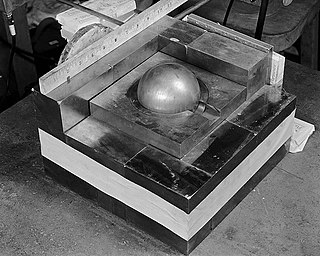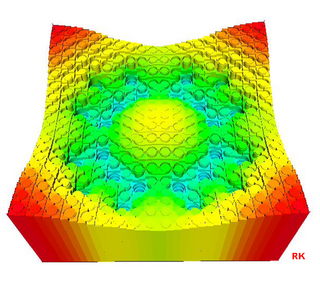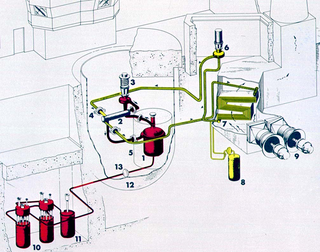
In nuclear physics, a nuclear chain reaction occurs when one single nuclear reaction causes an average of one or more subsequent nuclear reactions, thus leading to the possibility of a self-propagating series or "positive feedback loop" of these reactions. The specific nuclear reaction may be the fission of heavy isotopes. A nuclear chain reaction releases several million times more energy per reaction than any chemical reaction.

In nuclear engineering, a critical mass is the smallest amount of fissile material needed for a sustained nuclear chain reaction. The critical mass of a fissionable material depends upon its nuclear properties, density, shape, enrichment, purity, temperature, and surroundings. The concept is important in nuclear weapon design.

In mathematics, an eigenfunction of a linear operator D defined on some function space is any non-zero function in that space that, when acted upon by D, is only multiplied by some scaling factor called an eigenvalue. As an equation, this condition can be written as
In plasma physics, the particle-in-cell (PIC) method refers to a technique used to solve a certain class of partial differential equations. In this method, individual particles in a Lagrangian frame are tracked in continuous phase space, whereas moments of the distribution such as densities and currents are computed simultaneously on Eulerian (stationary) mesh points.
The fission-fragment rocket is a rocket engine design that directly harnesses hot nuclear fission products for thrust, as opposed to using a separate fluid as working mass. The design can, in theory, produce very high specific impulse while still being well within the abilities of current technologies.
In linear algebra, a circulant matrix is a square matrix in which all rows are composed of the same elements and each row is rotated one element to the right relative to the preceding row. It is a particular kind of Toeplitz matrix.

Neutron scattering, the irregular dispersal of free neutrons by matter, can refer to either the naturally occurring physical process itself or to the man-made experimental techniques that use the natural process for investigating materials. The natural/physical phenomenon is of elemental importance in nuclear engineering and the nuclear sciences. Regarding the experimental technique, understanding and manipulating neutron scattering is fundamental to the applications used in crystallography, physics, physical chemistry, biophysics, and materials research.
In nuclear engineering, a prompt neutron is a neutron immediately emitted by a nuclear fission event, as opposed to a delayed neutron decay which can occur within the same context, emitted after beta decay of one of the fission products anytime from a few milliseconds to a few minutes later.
Monte Carlo N-Particle Transport (MCNP) is a general-purpose, continuous-energy, generalized-geometry, time-dependent, Monte Carlo radiation transport code designed to track many particle types over broad ranges of energies and is developed by Los Alamos National Laboratory. Specific areas of application include, but are not limited to, radiation protection and dosimetry, radiation shielding, radiography, medical physics, nuclear criticality safety, detector design and analysis, nuclear oil well logging, accelerator target design, fission and fusion reactor design, decontamination and decommissioning. The code treats an arbitrary three-dimensional configuration of materials in geometric cells bounded by first- and second-degree surfaces and fourth-degree elliptical tori.

Nuclear reactor physics is the field of physics that studies and deals with the applied study and engineering applications of chain reaction to induce a controlled rate of fission in a nuclear reactor for the production of energy. Most nuclear reactors use a chain reaction to induce a controlled rate of nuclear fission in fissile material, releasing both energy and free neutrons. A reactor consists of an assembly of nuclear fuel, usually surrounded by a neutron moderator such as regular water, heavy water, graphite, or zirconium hydride, and fitted with mechanisms such as control rods which control the rate of the reaction.
The Monte Carlo trolley, or FERMIAC, was an analog computer invented by physicist Enrico Fermi to aid in his studies of neutron transport.

The Molten-Salt Reactor Experiment (MSRE) was an experimental molten salt reactor research reactor at the Oak Ridge National Laboratory (ORNL). This technology was researched through the 1960s, the reactor was constructed by 1964, it went critical in 1965, and was operated until 1969. The costs of a cleanup project were estimated at $130 million.
Plane wave expansion method (PWE) refers to a computational technique in electromagnetics to solve the Maxwell's equations by formulating an eigenvalue problem out of the equation. This method is popular among the photonic crystal community as a method of solving for the band structure of specific photonic crystal geometries. PWE is traceable to the analytical formulations, and is useful in calculating modal solutions of Maxwell's equations over an inhomogeneous or periodic geometry. It is specifically tuned to solve problems in a time-harmonic forms, with non-dispersive media.
Geometric buckling is a measure of neutron leakage and material buckling is a measure of the difference between neutron production and neutron absorption. When nuclear fission occurs inside of a nuclear reactor, neutrons are produced. These neutrons then, to state it simply, either react with the fuel in the reactor or escape from the reactor. These two processes are referred to as neutron absorption and neutron leakage, and their sum is the neutron loss. When the rate of neutron production is equal to the rate of neutron loss, the reactor is able to sustain a chain reaction of nuclear fissions and is considered a critical reactor.

The liquid fluoride thorium reactor is a type of molten salt reactor. LFTRs use the thorium fuel cycle with a fluoride-based molten (liquid) salt for fuel. In a typical design, the liquid is pumped between a critical core and an external heat exchanger where the heat is transferred to a nonradioactive secondary salt. The secondary salt then transfers its heat to a steam turbine or closed-cycle gas turbine.
Population balance equations (PBEs) have been introduced in several branches of modern science, mainly in Chemical Engineering, to describe the evolution of a population of particles. This includes topics like crystallization, leaching (metallurgy), liquid–liquid extraction, gas-liquid dispersions like water electrolysis, liquid-liquid reactions, comminution, aerosol engineering, biology (where the separate entities are cells based on their size or intracellular proteins), polymerization, etc. Population balance equations can be said to be derived as an extension of the Smoluchowski coagulation equation which describes only the coalescence of particles. PBEs, more generally, define how populations of separate entities develop in specific properties over time. They are a set of Integro-partial differential equations which gives the mean-field behavior of a population of particles from the analysis of behavior of single particle in local conditions. Particulate systems are characterized by the birth and death of particles. For example, consider precipitation process (formation of solid from liquid solution) which has the subprocesses nucleation, agglomeration, breakage, etc., that result in the increase or decrease of the number of particles of a particular radius (assuming formation of spherical particles). Population balance is nothing but a balance on the number of particles of a particular state (in this example, size).
The multiphase particle-in-cell method (MP-PIC) is a numerical method for modeling particle-fluid and particle-particle interactions in a computational fluid dynamics (CFD) calculation. The MP-PIC method achieves greater stability than its particle-in-cell predecessor by simultaneously treating the solid particles as computational particles and as a continuum. In the MP-PIC approach, the particle properties are mapped from the Lagrangian coordinates to an Eulerian grid through the use of interpolation functions. After evaluation of the continuum derivative terms, the particle properties are mapped back to the individual particles. This method has proven to be stable in dense particle flows, computationally efficient, and physically accurate. This has allowed the MP-PIC method to be used as particle-flow solver for the simulation of industrial-scale chemical processes involving particle-fluid flows.
Serpent is a continuous-energy multi-purpose three-dimensional Monte Carlo particle transport code. It is under development at VTT Technical Research Centre of Finland since 2004. Serpent was originally known as Probabilistic Scattering Game (PSG) from 2004 to the first pre-release of Serpent 1 in October 2008. The development of Serpent 2 was started in 2010. The current stable version Serpent 2.2.0 was released in May 2022.
The closest point method (CPM) is an embedding method for solving partial differential equations on surfaces. The closest point method uses standard numerical approaches such as finite differences, finite element or spectral methods in order to solve the embedding partial differential equation (PDE) which is equal to the original PDE on the surface. The solution is computed in a band surrounding the surface in order to be computationally efficient. In order to extend the data off the surface, the closest point method uses a closest point representation. This representation extends function values to be constant along directions normal to the surface.
In the theory of radiative transfer, of either thermal or neutron radiation, a position and direction-dependent intensity function is usually sought for the description of the radiation field. The intensity field can in principle be solved from the integrodifferential radiative transfer equation (RTE), but an exact solution is usually impossible and even in the case of geometrically simple systems can contain unusual special functions such as the Chandrasekhar's H-function and Chandrasekhar's X- and Y-functions. The method of discrete ordinates, or the Sn method, is one way to approximately solve the RTE by discretizing both the xyz-domain and the angular variables that specify the direction of radiation. The methods were developed by Subrahmanyan Chandrasekhar when he was working on radiative transfer.






































